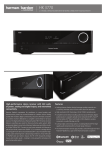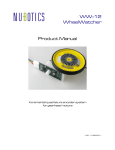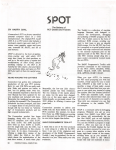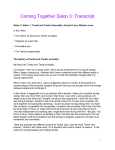Download ESP Lamp - Images SI, Inc.
Transcript
Images SI, Inc. 109 Woods of Arden Road Staten Island NY 10312 718.966.3694 tel 718.966.3695 fax http://www.imagesco.com ESP Lamp User Manual 1 Table of Contents Introduction ESP Lamp Applications History Helmut Schmidt Amazing Kreskin Serious Science Dean Radin Global Consciousness Project PEAR Generation of Random Numbers How Random Numbers Are Generated from Background Radiation Powering the ESP Lamp PSI Testing and Use Precognition Psychokinesis Telepathy Fortune Telling—Telephone to God Mood Lamp Radioactive Fallout detector Hardware and Software Additional Resources 2 3 4 4 4 4 4 4 5 5 5 6 7 7 7 7 8 8 8 8 8 Introduction to the ESP Lamp The ESP Lamp provides several areas of cutting edge research for users to dabble in; from the mind's ability to influence machines and probability at the quantum level to ESP testing. The ESP lamp contains a miniature Geiger counter that triggers the generation of true random numbers. Each random number generated will light one of four different color LED's; red, green, blue and yellow. While this set up might at first to appear trivial, it is not, and may be used to accurately test for different aspects of ESP. The ESP lamp may be used as a fortune telling device in the "telephone to God" mode ( see page 4). It can also function as a nuclear bomb / fallout detector. And when not being used in any of the above applications, the ESP lamp is a random mood lamp with a very high coolness factor. The ESP lamp may be used to check an individual or group’s ESP / PSI potential, and the ability of the mind, (or collec- 2 tive minds in a group) to influence either the ESP Lamps circuit (machine) and/or natural random events. ESP Lamp Applications: Test for Precognition: Precognition is the knowledge of something in advance of its occurrence, especially by extrasensory perception; also called clairvoyance. Test for Psychokinesis (PK): Psychokinesis is the movement or influence of physical objects by the mind without use of physical means, also called PK. Test for Telepathy: Telepathy is the communication between minds by some means other than sensory perception. Fortune Telling; Telephone To God: Fortune telling is the act or practice of predicting the future. Mood Lamp: a lamp which changes color that may depict the user’s state of mind 3 Radioactive Fallout Detector: The slow descent of minute particles of radioactive debris in the atmosphere following a nuclear explosion. History: Helmut Schmidt, a physicist for the Boeing Company Laboratory, created a number of RNG used for mind-over-machine experiments back in 1969. The use of electronic RNG and REG began with his experiments. One experiment used a RNG connected to four colored lights, in a similar manner to the ESP Lamp. His experiments concluded that the human mind can influence the RNG output to produce statistical deviations from chance. The Amazing Kreskin, offered a electronic ESP tester through Edmund Scientific in 1975. This ESP tester used a RNG to light one of four different colored LEDs. In one ESP/PSI test scenario, the user would select which LED he thought would light next, then pressed a switch to have the RNG select a light randomly. The user kept track of his hits and misses to determine if they were exhibiting any ESP / PSI potential. Serious Science: It’s easy to be cynical about the ESP lamp and minimize the significance of the experiments and technology it represents. Other scientists who employed rigorous methodology and authored peer-reviewed materials have drawn conclusive results, that show a weak but definite ESP/PSI abilities of the human mind. These studies are based upon the statistical analysis of the results obtained using Random Event Generators (REG) and Random Number Generators (RNG). Here are a few terms for you to search the internet; Helmut Schmidt, PEAR, Dean Radin (IONs) and Global Consciousness Project. These searches will generate a wealth of information based on science and to form a solid foundation of this research. Helmut Schmidt we already touched upon in the history section. Dean Radin, PhD, is the Senior Scientist at the Institute of Noetic Sciences (IONS). He has written extensively on PSI phenomena and experiments, far more eloquently than I have. His books; “The Conscious Universe” and “Entangled Minds” are pivotal, interesting and eye opening. Global Consciousness Project started in 1998 has the premise, that human consciousness can have an impact on the output of Random Event Generators (REG). The impact being that statisti- 4 cally the REG will become a slightly less random. If this premise is true then global events ought to have a measurable impact on a network of global REG’s. These REG’s were analyzed during Princess Diana’s funeral and on 9-11-2001. There was a measurable impact on the output of the networked REG’s in the Global Consciousness Project. While connecting our ESP lamp to the Global Consciousness Project is not possible, the ESP lamp has a TTL output that can be read by a pc. PEAR is an acronym for the Princeton Engineering Anomalies Research. The mind’s over machine phenomena was researched extensively at Princeton led by Robert G. Jahn. His group of researchers tested the human mind’s ability to influence the behavior of machines. His statistical results shown a weak but positive undeniable correlation. Generation of Random Numbers To detect random events, our ESP lamp relies on the immutable randomness of an atom’s radioactivity decay. Quantum mechanics states that the nuclear decay of atoms, are fundamentally random and cannot be predicted. Our device contains a mini-Geiger counter that detects background radiation that consists of three main sources: cosmic, terrestrial, and internal. Cosmic radiation comes from the sun and stars. Terrestrial radiation comes from low levels of uranium, thorium, and their decay products in the soil, air and water. Internal radiation comes from radioactive potassium-40, carbon-14, lead-210, and other isotopes found inside our bodies. Background radiation is an ideal random event trigger for the RNG because it is impossible to predict with any accuracy the exact moment a radioactive particle will be detected. How Random Numbers are Generated from Background Radiation: The way the random number generator operates is best described by first using a mechanical analogy. Imagine if you will numbers one to four painted on the edge of a revolving carnival wheel. There is a pointer at the top that indicates the number at the top of the wheel. The wheel is set into motion, spinning very rapidly, thousands of revolutions per second. Then at any given “random” moment in time the wheel is instantly stopped, and the number indicated under the pointer becomes our random number. 5 Once the number is read, the wheel is set back into motion. The microcontroller program follows pretty close to the mechanical analog. The microcontroller spins the sequence of numbers, one through four, in a for-next loop. The random event instantly stops the for-next loop, and the current number of the for-next loop is read, displayed via LED’s and sent out serially on the TTL port. Then the program reenters the for-next. The ESP Lamps’ RNG will produce approximately one to two random numbers every minute from background radiation. In the event that the RNG produces the same random number as is being displayed, for instance the random number generator produces 2 then 2 again, the LED light associated with 2 will momentarily blink off signaling that same random number was generated as is being displayed. Further, it is not uncommon for the same random number to be generated multiple times in sequence. Most people if they were to look at a list of random numbers would not choose a list of numbers that has the same number listed 6 to 10 in a row. Nor would a person, if asked to create a random number list, sequence the same number many times in a row. But real random number tables do contain these runs. Consider these runs a trait of a true RNG. Powering the ESP Lamp Plug the 9V wall adaptor into the power socket at the back of the lamp. Turn the ESP Lamp on using the on-off toggle switch. When the lamp is first turned on, each colored LED inside the lamp will blink on for one-half a second in sequence. This is the Lamp’s power on test, it lets you know the microcontroller and LED’s are working properly. After the self test, all the LED’s will be turned off. When the first radioactive particle is detected, one of the LED’s will turn on, corresponding to the random number generated. To determine which number is associated with each LED color, watch the ESP lamp’s self test when you turn it on. Take note which LED color lights first, that LED color 6 is associated with the number 1. The second LED color to light during the self test is number 2, the third, number 3 and the forth, number 4. So the lighting sequence is LED #1, LED #2, LED #3 and LED #4 in sequence. There are 24 various LED color to number combinations. So if you purchase two ESP Lamps, they may not have the same color light and number associations. While we would like to make every ESP Lamp unique to every buyer, at this time we just have 24 LED light variations. PSI Testing and Use: Precognition: Testing for precognition is simple. Predict the next 60 colors that the ESP Lamp will generate on a piece of paper. Then observe the ESP Lamp and mark the results against your guesses. Chance for guessing the right color is one out of four (p=1/4). So chance alone will provide an average of fifteen correct hits out of sixty calls. However, any number of hits within the range of 9 to 21 hits is NOT considered significant, because this range is within two standard deviations from chance. But any number of hits above and below this range is significant and is considered showing ESP/PSI activity. Psychokinesis (PK): Use your mind to influence and output from the ESP lamp; either greater or lesser than chance. Choose a single color (or number) to intend. Try to make that color come out, write down the next sixty ESP Lamps’ colors while trying to intend your color. Chance will provide approximately 15 hits. Anything above and below the range 9 to 21 range shows is statistically significant. It had been observed that groups of people all intending the same color or number have a higher success rate than individuals. This could be a game to try at your next party. Telepathy: Two people in separate rooms, one is a sender the other a receiver. The sender observes the ESP lamp, and tries to transmit the ESP Lamp color changes when they occur, to the receiver. A signal must be established between the sender and receiver. The sender signals when the lamp changes color, then the receiver tries to receive the impression of the color from the sender. Both the sender and receiver logs the colors for comparison later. Telephone To God: in this application, the lamp becomes a sophisticated “magic 8-ball” type of device. You ask a question and wait for the reply which is answered with the next lit LED. You can assign your own answers to the colors, for example, green for yes, red for no, yellow for unclear, blue for ask again. 7 Mood Lamp: the changing LED color output of the ESP lamp is unpredictable both in time and color. You can look at it as a sophisticated mood lamp, or the ramblings of the universe at large or maybe an example of God talking but no one is listening. Radioactive Fallout / Nuclear Bomb Detector: The ESP Lamp is sensitive to increase in radioactivity. If a piece of radioactive material like uranium ore is brought close to the lamp, the LED’s will start changing colors rapidly. If your lamp begins to change colors rapidly for an extended period of time, you may have an increase in background radiation. Hardware and Software for the ESP Lamp Images SI Inc. is planning a optional hardware adaptor with PC Windows software to read the output of the ESP Lamp’s RNG to use the PC to test PSI. This is schedule for release in 2011. Look at our main website for update information: http://www.imagesco.com/psi/esp.html Additional Resources: The internet contains a wealth of information on PSI phenomena. Be careful, there are many fringe groups and out right looney tunes on the internet. So stay close to real science. One interesting PSI testing website I found you can use to calculate the probability of your test results using the ESP Lamp is: http://www.psychicscience.org/stat1.aspx Have an interesting experience using our ESP Lamp? Let us know! We are interested in your experiences using our ESP Lamp. So if you have an interesting experience email us with your story. Details may be important, so if you can tell us; what happened, who was there, when it happen and where. No phone calls please. Email your experience to : [email protected] How are we doing? Let us know your suggestions and comments, both good and bad. What you think we got right and perhaps not so right. We are always looking to improve our products and performance. Email comments and suggestions to us at: 8 [email protected]


















